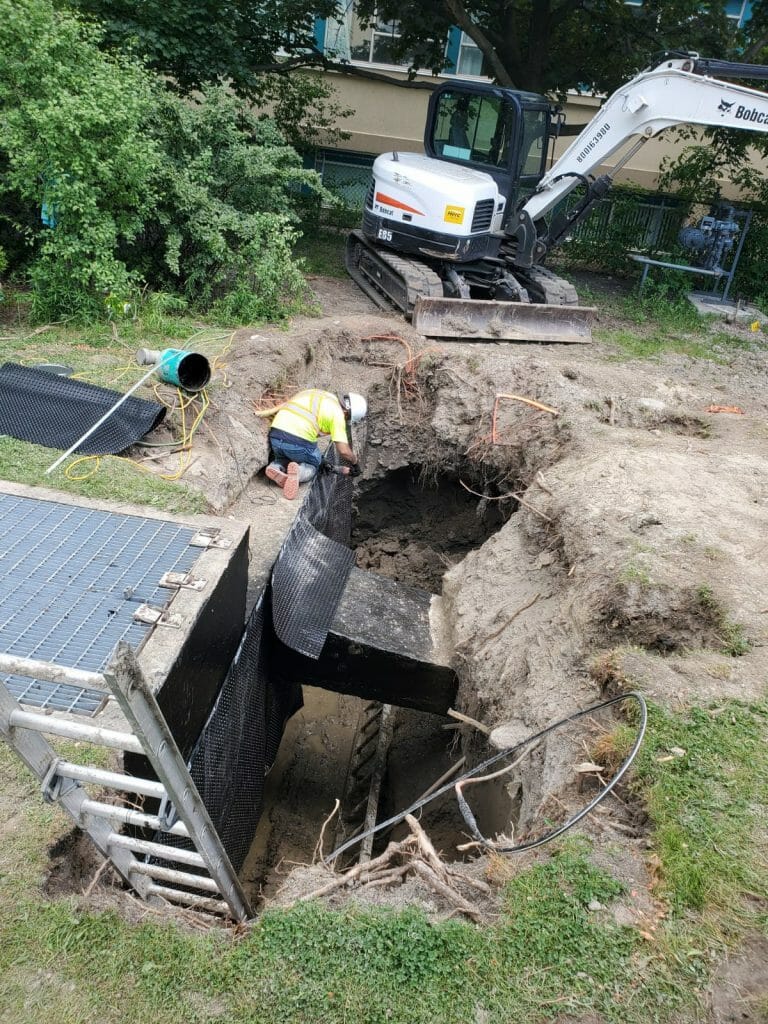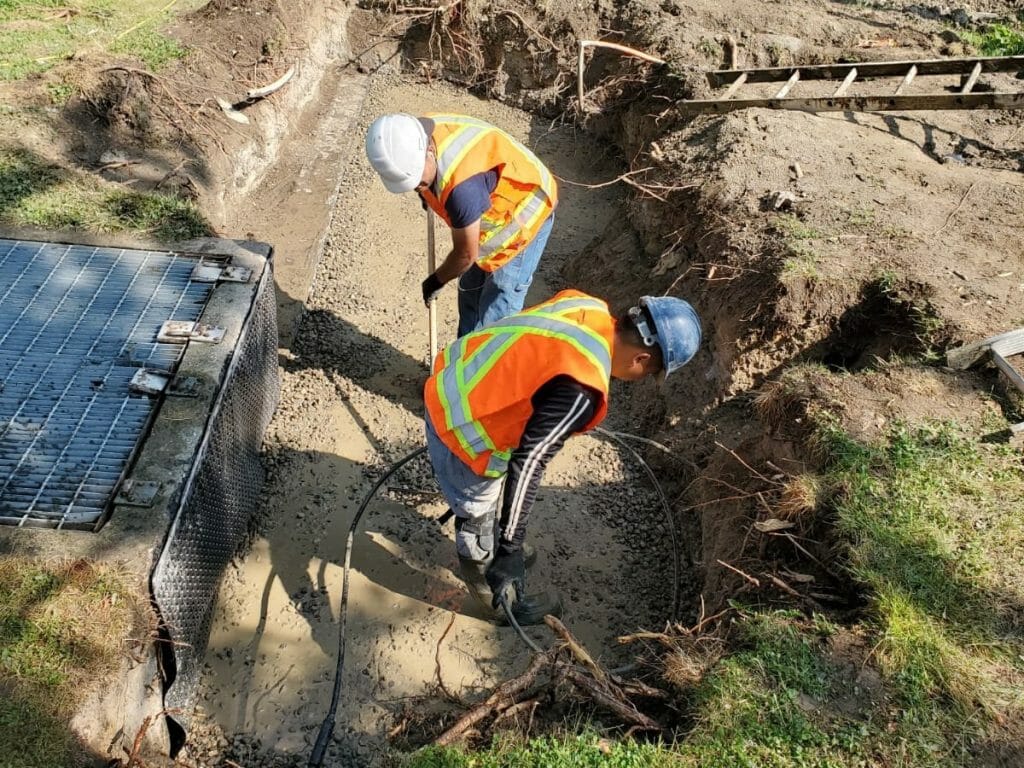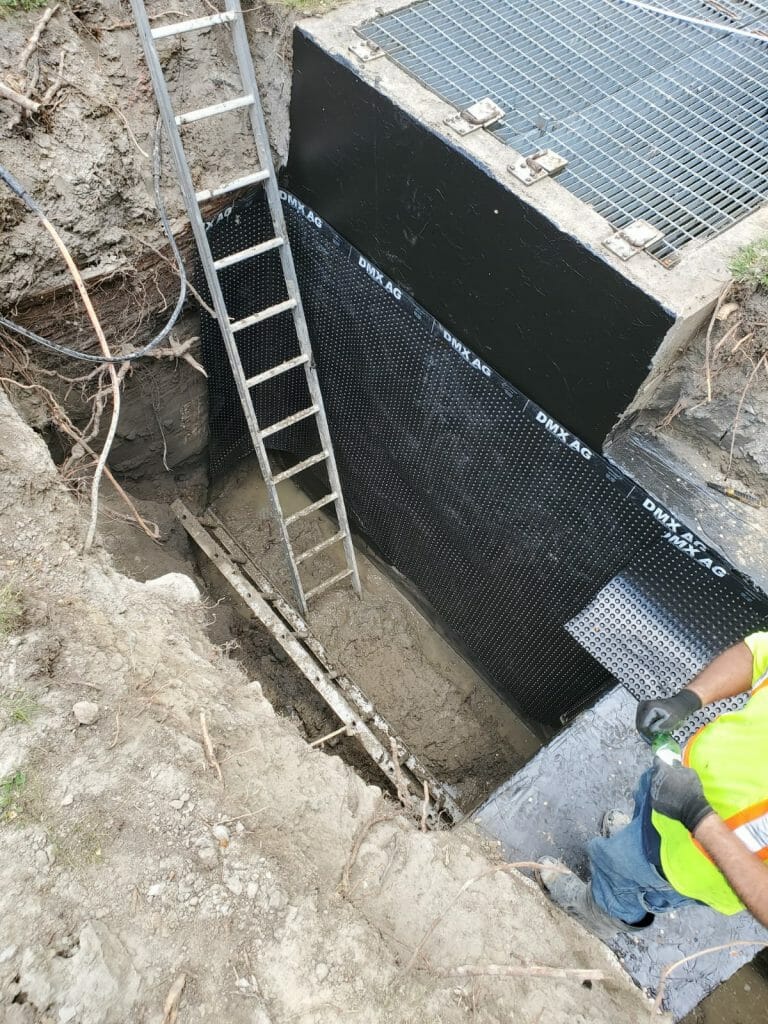
In the thriving metropolis of Toronto, where residential and commercial properties dominate the vibrant urban landscape, the significance of basement waterproofing cannot be overstated. This crucial process plays a pivotal role in ensuring the long-term durability and structural integrity of residential and commercial properties in Toronto. As such, it is imperative for property owners to prioritize and give due consideration to waterproofing measures. By understanding the importance of basement waterproofing, property owners can effectively protect their investment and ensure the long-term value of their properties.
That being said, it is crucial to recognize that properties in Toronto are particularly susceptible to water infiltration due to the challenging Canadian climate and unique geological characteristics of the region. For example, the city experiences frequent rainfall, elevated humidity levels, and periodic bouts of severe weather conditions. These factors exert considerable stress on the foundations of structures, rendering basements susceptible to cracks, leaks, and seepage that pose potential risks to overall structural integrity. Consequently, in order to confront these challenges and secure property protection, a comprehensive understanding of basement waterproofing techniques is indispensable.
With that goal in mind, we have created this comprehensive guide to assist you in waterproofing your basement. This step-by-step approach will provide you with valuable insights and expert advice, helping you navigate the complexities involved in this critical process. In this guide, we will explore various aspects of basement waterproofing, including the reasons for water infiltration and potential problem areas. Furthermore, we will provide a detailed explanation of effective waterproofing techniques. This will help property owners and managers effectively protect their properties from water damage. By following this comprehensive resource, you will be equipped with the knowledge and tools necessary to address water-related issues in your basement, enhancing the durability and value of your property.
Whether you are a homeowner in need of practical solutions for a damp basement or a business owner seeking to protect your commercial space from water damage, this guide is here to serve as your ultimate resource. This comprehensive, step-by-step guide will provide you with the knowledge and strategies necessary to make informed decisions and take proactive measures to effectively combat water intrusion. For more information, please continue reading.

When it comes to protecting your property from water infiltration and its damaging effects, it is crucial to understand the root causes of basement water seepage. Whether you are a homeowner or a property manager in Toronto, having knowledge about the factors that contribute to basement water infiltration empowers you to take proactive measures and implement effective waterproofing strategies. That being said, we acknowledge the challenges that come with identifying the root causes of water infiltration. Thus, to address the prevalent issue of water seepage and dampness in Toronto basements, this section of our comprehensive step-by-step guide will specifically focus on this topic.
With that being said, let’s embark on an informative journey to uncover the root causes of basement water infiltration and explore effective solutions for achieving a dry and resilient foundation. Below, we have curated a list of common triggers for a wet basement in Toronto. Our objective is to provide you with a clearer understanding of these factors and support you in developing targeted solutions.
1)Poorly Graded Soil: If the earth adjacent to your house is level or slopes back towards the foundation, it can direct water towards the foundation, potentially causing seepage into the house. Notably, if the surrounding soil contains clay, it worsens the issue by retaining water and creating an environment that promotes water buildup around the foundation.
2)Missing or Improperly Draining Gutters and Downspouts: Blocked or malfunctioning gutters can also cause water to overflow and collect near the foundation, which increases the risk of water infiltration. Similarly, if downspouts lack appropriate extensions or diverters, they may fail to properly direct water away from the house.
3)Poorly Designed Window Wells: Window wells, which are excavated pockets surrounding basement windows, can become waterlogged if they are not designed to effectively drain water away from the house.
4)Poorly Installed Window Well Covers: Window well covers serve as barriers against debris and water, preventing them from entering basement windows. However, if these covers are loose or missing, water can reach and infiltrate the basement through the windows.
5)Ineffective Drain Tile: Drain tile, which is a buried drainage system surrounding the outer perimeter of the house, plays a crucial role in redirecting water away from the foundation. However, if the drain tile becomes blocked or crushed, it can impede proper water drainage.
6)Blocked French Drains: French drains are buried drainage systems that can be susceptible to blockage from soil or root intrusion, which can hinder their ability to effectively channel water away from the foundation.
7)Sump Pump Not Draining: A sump pump that is inoperable or functioning poorly in the basement can fail to effectively drain rising water, leaving the basement vulnerable to flooding.
8)Water Up Through the Sump: In the event of extreme flood conditions, water can infiltrate the basement through the sump pit, overwhelming the sump pump system. Consequently, water will start seeping into the foundation of the structure.
9)Structural Cracks: Cracks in the foundation wall create pathways for water to penetrate the basement. It is essential to address and repair these cracks in order to prevent water infiltration. These cracks emerge as a result of stress on the concrete and act as pathways for water to infiltrate.
10)Deteriorated Exterior Waterproofing: Exterior waterproofing compounds deteriorate over time, which weakens their protective barrier against water intrusion. This degradation occurs because waterproofing materials are unable to accommodate the constant contraction and expansion of settling concrete. As a result, most waterproofing coatings eventually degrade or separate, rendering them ineffective.
By being aware of these common causes of basement water infiltration, you can take the necessary steps to reduce risks and safeguard your property against water damage. With that being said, it is highly recommended to seek guidance from professionals such as Desa Contracting & Restoration. They can help you implement targeted solutions that address the specific issues identified in your basement.
Furthermore, homeowners can prevent basement leakage by internally sealing the pores in the concrete foundations of their properties to prevent water migration. It is also advisable to use alkali deactivators on concrete surfaces to protect both the concrete itself and any applied waterproofing coating from potential “alkali attack.” By understanding these underlying causes and taking appropriate measures, such as sealing and alkali protection, homeowners can effectively reduce water infiltration in their basements and strengthen their property against future water-related challenges


To effectively resolve water infiltration in basements, it is crucial to implement a comprehensive waterproofing strategy. Unfortunately, many homeowners are unaware of what constitutes an effective strategy. Simply seeing a black waterproofing membrane peeping over the top of the exterior foundation wall might lead to the assumption that one’s home is adequately protected. However, this is not always the case. While a waterproofing membrane can act as a barrier against water, it may not be sufficient by itself. That being said, the real concern lies in the inadequate waterproofing during the construction phase. Foundation failure often remains unnoticed until a serious problem arises.
For instance, minor leaks, if left unaddressed or unnoticed, can pose health risks and cause substantial damage to the underlying structural supports. Excessive moisture not only fosters the growth of mold and mildew but also compromises indoor air quality, posing a risk to the health of occupants. Additionally, untreated water issues can cause damage to valuable belongings, equipment, and infrastructure, resulting in significant financial losses. Therefore, basement waterproofing is a critical and paramount concern that demands unwavering attention from property owners and managers in Toronto to ensure the protection of their properties.
With this in mind, this section of our comprehensive guide offers a user-friendly and systematic approach to effectively and permanently resolving all of your waterproofing challenges. The objective here is to help property owners and managers effectively address any water-related issues that may arise from leaks or cracks in their property’s foundation. With that being said, let us now delve into a detailed examination of each of the eight steps involved in basement waterproofing.

The initial and most challenging step in this process is excavation, which necessitates the utilization of heavy equipment to excavate soil and debris up to the complete height of the wall. Through this excavation, the foundations are exposed, allowing for the identification of the wet tile. In order to effectively accommodate the work of professionals, the surrounding work area is cleared to a significant width, potentially spanning the length of a wall or the entire perimeter of the house. That being said, depending on the specific circumstances, the excavation depth can extend up to eight feet.
After completing the excavation, the outer foundation is fully exposed, and the area is thoroughly pressure washed to remove any dirt or loose concrete. This thorough cleaning prepares the foundation for professionals to conduct a meticulous inspection. This allows them to identify any cracks or gaps that may be the source of the water infiltration problem.
In order to restore the foundation walls to their original structural integrity, it is essential to address any gaps or fractures present by using a strong hydraulic cement. This specialized mixture is designed to effectively seal and stabilize the affected areas. Once applied, the cement typically undergoes a hardening process within a few hours, guaranteeing a durable and long-lasting solution. To achieve a refined and aesthetically pleasing appearance, the hardened cement can be expertly polished using a trowel, resulting in a smooth and finished surface. This meticulous approach not only reinforces the structural integrity of the foundation walls, but it also enhances their overall visual appeal.
To achieve reliable waterproofing, the next crucial step involves installing a liquid membrane. The membrane is expertly applied to the foundation walls, footings, and other essential structural components using a trowel. Composed typically of rubberized asphalt, this specialized coating plays a pivotal role in effectively bridging cracks and fissures, safeguarding against water infiltration. The meticulous application process, carried out with precision and expertise, ensures the overall reliability and effectiveness of the waterproofing solution.
To enhance protection against issues like mold, mildew, rot, and water seepage, we further strengthen our defense by incorporating a specially designed open-weave glass cloth. This innovative cloth, with its distinctive bright color, serves a dual purpose during the application process. Firstly, its vibrant color helps in identifying any areas that are not covered, ensuring complete coverage of the coating compound. Secondly, the open-weave structure of the cloth allows for optimal adhesion to the underlying surface, enhancing the overall effectiveness and durability of the coating. By incorporating this meticulously designed glass cloth into the waterproofing procedure, we strengthen the barrier against potential water-related issues and offer durable protection for your property.
To enhance the foundation’s protection, we apply an additional layer of Aqua-Bloc liquid membrane. This specialized coating acts as a strong shield, enhancing the effectiveness of the waterproofing system and fortifying the foundation against water infiltration. By applying the Aqua-Bloc liquid membrane carefully, we ensure comprehensive coverage and create a resilient barrier that can withstand potential water-related challenges. This meticulous step adds an additional layer of defense, reinforcing the durability and longevity of the waterproofing solution. It further safeguards your property against the damaging effects of moisture.
The second-to-last step in the waterproofing process is to install a weeping tile system that effectively manages water drainage. This step is essential for alleviating the strain on foundation walls. The weeping tile system consists of carefully constructed layers, beginning with cleaned gravel to ensure proper filtration and drainage. To ensure efficient drainage, strategically placed perforated PVC pipes are then used to divert water away from the house. Furthermore, a filtration fabric is included to prevent the entry of particles that could potentially hinder the functionality of the system. By implementing this comprehensive weeping tile system, we can proactively address concerns related to water accumulation and enhance the overall stability and longevity of the foundation.
Lastly, the final task entails placing a layer of 16-inch gravel over the weeping tile, followed by backfilling the entire excavation site with soil. This meticulous step serves multiple purposes, including providing additional support to the weeping tile system and promoting proper water drainage. The 16-inch layer of gravel serves as a protective barrier, preventing soil from intruding and facilitating the efficient flow of water towards the weeping tile. Furthermore, during the backfilling process of the excavation site, utmost care is taken to ensure proper compaction of the soil. This is crucial to promoting stability and preventing any potential settlement issues. By completing this crucial step, we not only enhance the effectiveness of the weeping tile system but also restore the aesthetic appeal of the surrounding area. This leaves your property with a well-structured and harmonious finish.
Considering this, it is crucial for property owners and managers in Toronto to address water infiltration by implementing an effective waterproofing strategy. The potential consequences of water damage in basements, such as structural deterioration, health risks, and financial losses, highlight the critical need for comprehensive basement waterproofing. To that end, it is important to understand the limitations of a simple waterproofing membrane and recognize the hidden dangers of undetected foundation failures. By doing so, we can make informed decisions and take proactive measures to address these issues.
With that in mind, while repairing or improving waterproofing as part of a basement remodel can be costly and disruptive, it is of the utmost importance in safeguarding your investment and ensuring the longevity of your property. Moreover, by following the eight outlined steps, you can fortify your basement against water infiltration and mitigate potential issues. Remember, investing in professional basement waterproofing is an investment in the durability, integrity, and value of your property. In addition, it is important to seek guidance from a professional waterproofing expert in the event of a water damage emergency. They can provide tailored advice and solutions specific to your situation.



In conclusion, it is crucial for property owners and managers in Toronto to understand the importance of basement waterproofing. This is essential to protect their investments and ensure the long-term structural integrity of their residential and commercial properties. That being said, it is important to note that addressing the root causes of basement water infiltration requires a multifaceted approach, including comprehensive waterproofing strategies and professional guidance.
Fortunately, this comprehensive guide offers valuable insights and a systematic approach to assist property owners and managers in navigating the complexities of basement waterproofing. By utilizing this knowledge and following the recommended steps, we can successfully address water-related issues, safeguard our properties, and ensure long-term durability. Furthermore, by prioritizing basement waterproofing, we not only protect our investments but also improve indoor environments and promote the well-being of occupants.


Aurora, Bolton, Barrie, Brampton, Burlington, Caledon, Durham, East York, Etobicoke, Georgetown, Halton, King, Markham, Milton, Mississauga, North York, Oakville, Orangeville, Peel, Pickering, Richmond Hill, Scarborough, Thornhill, Toronto, Uxbridge, Vaughan and more.



